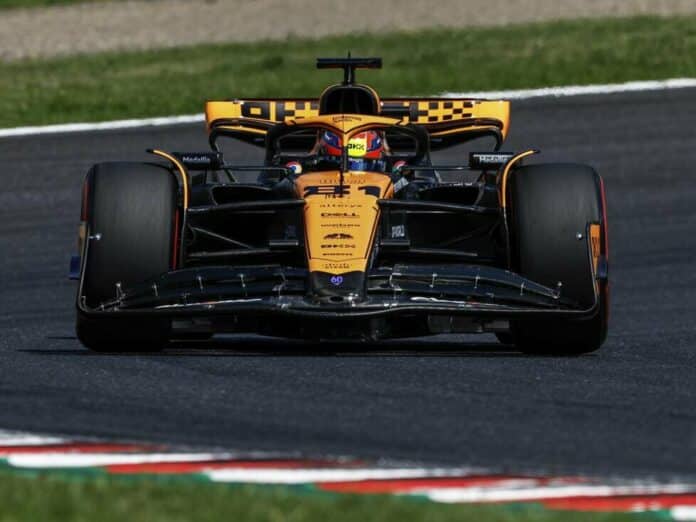Oscar Piastri and Lando Norris are P2/3, but in all likelihood still don’t stand a chance of winning the race at Suzuka
The McLaren team has no realistic chance of winning the race at the Japanese Grand Prix. Team boss Andrea Stella knows that too: if pole-sitter Max Verstappen can maintain the lead at the start, he says, “he’ll be so fast that it won’t be our race. Then our opponents will be Ferrari and Mercedes. ”
Oscar Piastri and Lando Norris had secured second and third place in qualifying at Suzuka, despite both failing to improve their lap times in the second Q3 attempt. Piastri lost more than two tenths of a second in the first sector. But the 0.6 seconds gap to Verstappen that stood at the end was not within reach.
“If we manage to get a car in front of Max, then maybe we can try something,” said Stella. “If not, then Max can get a head start and run his own race. So ideally we’ll take the lead at the start.”
But, “The most important thing for us is that Oscar doesn’t have a podium yet. If he manages to do that, it would be fantastic. And we want to get as many points as possible. So yes, of course we want to take the lead on the one hand. But on the other hand we have to be prudent not to jeopardise the points at the end of the race. ”
Just like Mercedes: second hard saved
Anyhow, the analysis of the long runs in Friday practice does not speak in McLaren’s favour. In the long run simulation, instead of six, even nine tenths of a second per lap were missing on Verstappen, and on the subject of tyre wear, only AlphaTauri was worse than McLaren. Even if Verstappen were to lose the lead at the start, he probably just needs to be patient.
“We’re glad we saved a second set of hard tyres for the race because that could be a good tyre here,” said Stella. “The other two compounds will overheat even more. Even the hard tyre overheats, but it seems better able to deliver good lap times. Let’s see if we can take advantage of this strategic advantage.”
“We have made progress on tyre wear. Still, we are nowhere near as good there as Red Bull, for example. Verstappen was able to repeat his lap time from Q1 even with used tyres. That shows that they are pretty easy on the tyres, because normally he drops about two tenths of a second per lap here. ”
McLaren expects to run a deficit until summer 2024
“But it is also clear: we are six tenths of a second short. Yes, you can improve tyre wear with aerodynamic developments, but we also need to look at other areas. That comes too late for this year’s car. I think we will carry that disadvantage until at least next summer.”
Looking a little closer at McLaren’s performance at Suzuka, it’s striking: Piastri loses the most time at three points on the track, according to telemetry. Firstly in the hairpin, secondly at Spoon, thirdly in the chicane. These are all corners that could also be in Singapore. In the flowing passages like the S-curves of the first sector, McLaren is competitive.
Verstappen gains time on McLaren almost everywhere. Most at hairpin, spoon and chicane. Because he can brake later there, and then still not lose momentum afterwards. JapaneseGP F12023 F1 Formula1 via @f1_tempo_ pic. twitter.com/bt5EYcP4fv
– Christian Nimmervoll (@MST_ChristianN) September 24, 2023
“I’m sorry to say that I was right in my expectation,” Stella analyses. “Both slow corners were particularly bad for us. We see in the GPS overlays that we lose time there on a lot of direct opponents.” This was not a negative surprise, however, but had already been seen coming after Singapore.
Stella: Time gap is bigger than expected
“We expected to be more competitive than at Silverstone,” says Stella. “Whether that would be enough to be second best team or whether Mercedes and Ferrari would be with us, we didn’t realise. Very clear to us was that Red Bull would in all likelihood be the fastest team.”
“They are just pretty good in every speed range of that layout. Verstappen is winning almost everywhere if you look at the telemetry. That’s remarkable and shows how much work we still have to do. P2 and P3 is a good result for the team. But I was hoping to be a bit closer.”
“Six tenths is quite a lot and indicates how much we still have to do. Maybe it’s a good thing, because it brings us back down to earth. Not that we have taken off, but we are now clearly aware that we need to bring much more aerodynamic performance to the car,” Stella explains.





